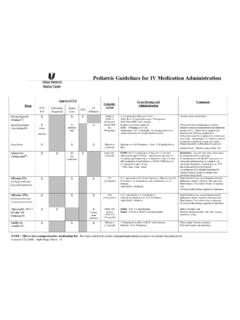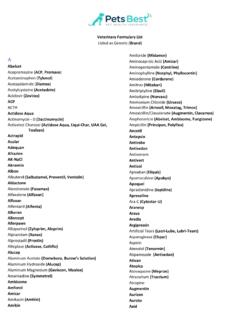Transcription of Guidelines for the Management of Acetaminophen Overdose
1 PROFESSIONAL PRODUCT INFORMATIONG uidelines for the Management of Acetaminophen Overdose ( Acetaminophen ) 38 This brochure outlines basic steps in the Management of Acetaminophen Overdose and reviews the application of these Management principles to special populations. It is a revision of previous publications and should be used in place of earlier versions. Included herein are flowcharts for managing both acute and chronic Acetaminophen Overdose , and a nomogram, which uses Acetaminophen serum concentrations at various time intervals following a single, acute Overdose to determine whether the antidote should be January 1985, the United States (US) Food and Drug Administration (FDA) approved the oral administration of acetylcysteine (N-acetylcys-teine, NAC) as an antidote for the treatment of Acetaminophen Overdose .
2 Approval of acetylcysteine for this purpose was based on a nationwide research program conducted by the Rocky Mountain Poison and Drug Center under the sponsorship of McNeil Consumer Healthcare. This research clearly demonstrated the efficacy of acetylcysteine, when used early in the course of treatment, in reducing morbidity and virtually elim-inating mortality associated with Acetaminophen Overdose . In 2004, the FDA approved the intravenous formulation of acetylcysteine ( acetadote , Cumberland Pharmaceuticals, Nashville, TN). (4 82) This monograph is intended to assist practitioners in managing acet-aminophen overdoses and is not meant as a standard of care. For further information concerning complex or difficult cases, please contact your local poison center (1-800-222-1222) or a clinical toxicologist.
3 McNeil Con-sumer Healthcare sponsors a toll free telephone number (1-800-525-6115), available 24 hours a day, at the Rocky Mountain Poison and Drug Center. Please do not hesitate to use these resources if you need individualized consultation on managing a patient with an Acetaminophen you would like additional information about TYLENOL (acetamino-phen), or additional copies of this Management protocol, please contact us at the address Consumer Healthcare7050 Camp Hill Road Fort Washington, PA 19034 Prepared by the consultant panel:G Randall Bond, MD E. Martin Caravati, MD, MPH Richard C. Dart, MD, PhD Kennon Heard, MD Robert S. Hoffman, MD Barry H. Rumack, MD Wayne R. Snodgrass, MD, PhDWith support from McNeil Consumer Healthcare Division of McNEIL-PPC, for the Management of Acetaminophen Overdose ( Acetaminophen ) 39 Guidelines for the Management of Acetaminophen Overdose 38 Table of Contents 39 Introduction 40 Definitions 41 Management of Acute Overdose 421.
4 Initial Assessment 422. Gastric Decontamination/Prevention of Absorption 423. Determining the Need for Acetylcysteine 43 Acetaminophen Assay ..434. Administration of Acetylcysteine 43a. Choose a route of administration ..43b. Transitioning from oral to intravenous acetylcysteine treatment.. 44c. Continuation of acetylcysteine treatment ..445. Other Laboratory Tests 446. Supportive Treatment 447. Special Considerations 45a. Extended release Acetaminophen ..45b. Ingestion of Acetaminophen combination products .. 45c. Massive Acetaminophen ingestion ..45d. Intravenous Acetaminophen ..458. Special Populations 46a. Young children (<6 years of age) ..46b. Pregnant women ..46c. Patients presenting 24 hours or more postingestion ..46d. Chronic alcohol users.
5 46e. Obese patients ..46f. Other diseases ..46 Management of Repeated Chronic Supratherapeutic Ingestion 47 Clinical Characteristics of Acute Acetaminophen Overdose 48 Phase I 48 Phase II 48 Phase III 48 Summary 49 Acetaminophen Overdose : Suggested Readings 54 Table of ContentsList of Figures, Flowcharts, and Charts Flowchart 1. Stepwise Management of Acute Acetaminophen Overdose 50 Flowchart 2. Stepwise Management of Repeated Supratherapeutic Ingestion 51 Chart 1. Rumack-Matthew Nomogram 52 Chart 2. Common Adverse Events Associated with the Oral and Intravenous Formulations of n-acetylcysteine.
6 53 ( Acetaminophen ) 40 IntroductionAn Overdose of Acetaminophen may result in severe liver injury. Acetylcysteine is an effective antidote to prevent or limit liver injury in patients with potentially toxic Acetaminophen levels or evidence of liver injury. ( Acetaminophen ) 41 Definitions Overdosage of Acetaminophen can occur following an acute Overdose or during repeated Overdose . Acute Acetaminophen Overdose is defined as an ingestion of a toxic amount of Acetaminophen occurring within a period of 8 hours or less. In adults and adolescents, hepatotoxicity may occur following ingestion of greater than to 10 grams (g) (eg, 24 regular-strength or 15 extra-strength caplets or tablets) over a period of 8 hours or less.
7 Fatalities are infrequent especially when treated with acetylcysteine ( of treated cases). A chronic Overdose is termed repeated supratherapeutic ingestion (RSTI) to differentiate from chronic therapeutic use. Ingestion of a toxic amount over a period greater than 8 hours is considered a repeated supratherapeutic ingestion. Acetylcysteine is the official term designated by USAN (United States Adopted Names) for N-acetylcysteine. ( Acetaminophen ) 42 Management of Acute OverdoseTo achieve optimal outcome following Acetaminophen Overdose , a systematic Management approach is needed. This section outlines basic steps in managing acute Acetaminophen Overdose , consistent with FDA approved labeling of acetylcysteine. Flowchart 1 outlines this stepwise Initial AssessmentAdults or adolescents (*12 years of age) who may have ingested Acetaminophen in a purposeful Overdose , independent of the amount reported to have been ingested, should be referred for medical evalu-ation.
8 Their evaluation includes careful estimation of the quantity and dosage form of the Acetaminophen ingested as well as assessment of any other substances ingested. The Acetaminophen level should be deter-mined at 4 hours post ingestion or as soon as possible thereafter (see also Special Considerations). Patients who present with a measurable Acetaminophen level and no clear time of exposure represent a treatment challenge and there is sub-stantial practice variation. In some cases it is possible to develop a worst case scenario for the time of ingestion ( the patient was with their family until 12 hours prior to presentation so ingestion could not have occurred more than 12 hours prior). In these cases, the earliest possible time of ingestion should be used to plot the Acetaminophen level on the nomogram (Chart 1).
9 If the time of ingestion is completely unknown, the most conservative approach is to initiate treatment and continue acetyl-cysteine until the Acetaminophen level is undetectable and there is no evidence of progressive hepatic injury (serum transaminases normal or near normal and stable over a 12 hour period). There is substantial practice variation in the Management of patients who have low level transaminase elevations and a questionable history of the time and amount of Acetaminophen exposure. In many of these cases the Acetaminophen level may be therapeutic or even undetectable. The most conservative approach in these cases is to initiate treatment and continue acetylcysteine until the Acetaminophen level is undetectable and there is no evidence of progressive hepatic injury (serum transaminases normal or near normal and stable over a 12 hour period).
10 2. Gastric Decontamination/Prevention of AbsorptionGastric decontamination should be carried out according to standard treatment Guidelines . Activated charcoal reduces the peak serum con-centration of Acetaminophen . This may reduce the 4 hour Acetaminophen level and thereby decrease the number of patients requiring treatment with acetylcysteine. Activated charcoal may be given during the immedi-ate postingestion period, especially in the case of a mixed drug Overdose . Data supporting the efficacy of activated charcoal beyond 2 hours after ingestion are limited. Administration of activated charcoal does not require a change in subsequent administration of oral or intravenous acetylcysteine therapy. ( Acetaminophen ) 433. Determining the Need for Acetylcysteine Acetaminophen Assay RationaleThe Acetaminophen level provides the basis for determining the need to initiate or continue treatment with acetylcysteine.


